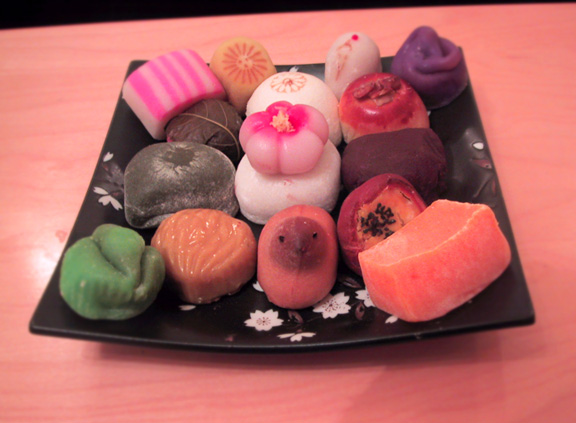Everyone is probably familiar with at least some Japanese foods, such as sushi and miso soup. Many people enjoy sushi for its aesthetic qualities along with its taste. When New Year’s comes around, the aesthetic of sushi doesn’t stand a chance against the intricately beautiful creation of osechi-ryouri, or just osechi.
1: Simmered shrimp, 2: Tazukuri, 3: Nishime, 4: Kamaboko, 5: Datemaki, 6: appetizer, 7: Konbumaki, 8:Kurikinton, 9: Tobiko, 10: Grilled sea bream, 11: Kazunoko, 12: Pickled vegetables, 13: Sweets, 14: appetizer, 15: Black beans, 16: Grilled lobster
Every food used in Osechi, which includes, but is not limited to, the ones shown above, holds a special meaning. The name Osechi itself is the traditional way of referring to a significant day or event.
Tazukuri is dried sardines cooked in soy sauce. The meaning of the Japanese character (田作り) is raising rice patties. Therefore, it symbolizes an abundant harvest in the new year.
The black beans, called kuromame, symbolize working hard in the new year, as “mame” means to be diligent.
Kamaboko are broiled fishcakes, which are pink with a white outline. Red and white are the festive colors of Japan, and they are said to look like the rising sun, representing both Japan and a new day.
As Kuro mentioned in her interview, many seaweed dishes are eaten. The seaweed used is called Konbu, because the similar word “yorokobu” means joy.
The tradition of eating Osechi began in 800 A.D. Over the years, as the Japanese language expanded, more and more dishes have been added to Osechi. It used to be only home-made, but now, many supermarkets and convenience stores in Japan sell Osechi when it is New Year’s time. Many Japanese supermarkets in the United States sell it too, but it is quite expensive.

Another important food eaten on New Year’s in Japan, which is much easier to prepare and much cheaper, is toshikoshi soba, buckwheat noodles which are extra long for New Year’s, symbolizing longevity. “Toshikoshi” means year-crossing, and the noodles are said to be very good luck. On the offhand, it is bad luck to leave any toshikoshi soba uneaten.
Last but certainly not least, mochi is the last food which MUST be eaten on New Year’s, no exception. Why? Simply because it is so delicious. Mochi is the only food eaten on New Year’s in Japan which doesn’t have a special reason, but it has been done for centuries and continues to be done today. Mochi is a glutenous rice cake. It is often handmade by pounding a rice mixture furiously with a hammer. It is then molded into beautifully delicious art.

New Year’s in Japan is a holiday with a large emphasis on food. Thankfully, Japanese people can still celebrate a traditional New Year’s in New York City, purchasing all the necessary ingredients from Japanese grocery stores.



